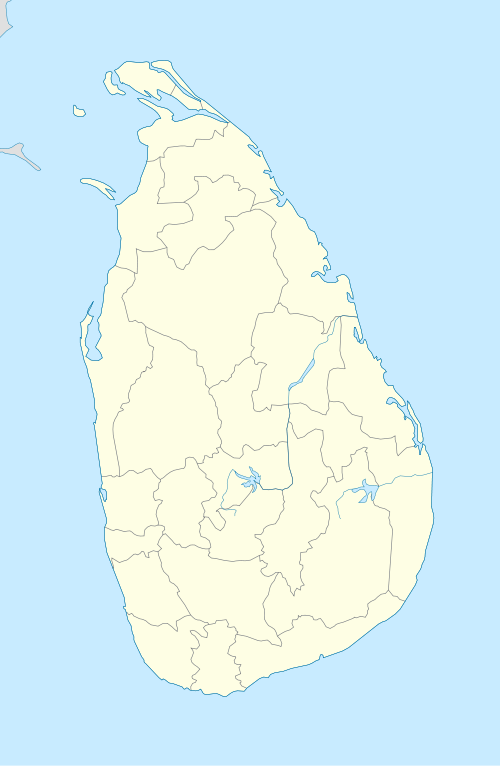Diyatalawa
| Diyatalawa | |
|---|---|
 | |
 Diyatalawa | |
| Coordinates: 6°48′00″N 80°58′01″E / 6.80000°N 80.96694°ECoordinates: 6°48′00″N 80°58′01″E / 6.80000°N 80.96694°E | |
| Province | Uva Province |
| Time zone | Sri Lanka Standard Time Zone (UTC+5:30) |
| • Summer (DST) | Summer time (UTC+6) |
Diyatalawa (දියතලාව) is a garrison town in the central highlands of Sri Lanka, in the Badulla District of Uva Province. It is at an altitude of 1,499 m (4,918 ft) and has become a popular destination for local holiday makers. It is home to the Diyatalawa Garrison of the Sri Lanka Army, which includes the Sri Lanka Military Academy, officer training center of the army; SLAF Diyatalawa, the Sri Lanka Air Force's ground combat training centre; and facilities of the Sri Lanka Police.
History
It is not known when Diyatalawa became a training station for troops, but available records show that it was selected around 1885, when the British Army first established a garrison at Diyatalawa. At that time training was conducted at the Imperial Camp which is now occupied by the Gemunu Watch troops. In 1900, the British War Office constructed a concentration camp in Diyatalawa to house Boer prisoners captured in the Second Boer War. Constructed to house 2500 prisoners and 1000 guards and staff, the number of prisoners increased to 5000. During World War I an internment camp for enemy aliens was set up.[1][2]
Early in World War II the camp was reopened and German nationals resident in Hong Kong and Singapore, as well as many sailors, like those removed from the Asama Maru in violation of international law, were housed here. Also imprisoned were Buddhist monks of German extraction like Nyanaponika and Govinda Anagarika who had acquired British citizenship. In June 1941 most of the sailors were transferred to Canada. The section for Germans was sensibly divided in a pro- and anti-Nazi wing. There was also a section set up to house Italian POWs. After the Japanese started bombing the island, inmates were on 23 February 1942 transferred to camps in India. Males usually went to Dehradun.[3] Officer training was also carried out here during the war.
After World War II the Royal Navy had a holiday station there, and it was often referred to as "DLA"; HMS Uva was situated at Diyatalawa with recreational facilities, which were also sometimes used by RAF personnel, such as from RAF Negombo/Katunayake, and their families; the facilities were later taken over by the Royal Ceylon Navy in 1956, commissioning it as HMCYS Rangalla and established its training center there. They had to move out in 1962 and it was taken over by the Gemunu Watch.
Sri Lanka gained its independence, as Ceylon, in 1948. In the mid-1950s, all British military facilities were taken over by the Sri Lankan services. In 1952 the Royal Ceylon Air Force established SLAF Diyatalawa.
Sporting events
Fox Hill, Diyatalawa is the venue for the annual Fox Hill Motor Cross organized by the Sri Lanka Military Academy, one of the premier motor racing events in the country.
The Fox Hill (Nariya Kanda in Sinhalese) was named after the engraving of the whole slope facing the railway station of Diyatalawa, by the British soldiers at the canteen town, with an image of a fox carved in with hundreds of rough rocks of quartes that were once lying scattered all over the hill. The Stag Hill (Gona Kanda in Sinhalese) too named following the same style of rock art on hill similar to Fox Hill.
Climate
Due to the high altitude, garrison town of Diyatalawa located between the hill station retreats of Haputale[4] and Bandarawela[5] of central highlands[6] has a much cooler climate than the lowlands of Sri Lanka, with a mean annual temperature of 16 °C. In the winter months it is quite cold at night, and there can even be frost.
Maps
See also
References
- ↑ The Bore Prisoners of War in Ceylon The Journal of the Dutch Burgher Union of Ceylon
- ↑ The Diyatalawa water works IESL
- ↑ de:Internierungslager in Indien
- ↑ http://www.mysrilankaholidays.com/haputale.html
- ↑ http://www.mysrilankaholidays.com/bandarawela.html
- ↑ http://www.mysrilankaholidays.com/central-highlands.html